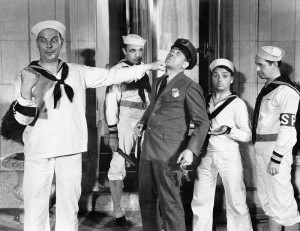The outcry over the use of deadly force by police officers has dominated headlines. Ferguson Missouri, New York City, Virginia, Texas, Florida. Although incidents involving unarmed black men have dominated the headlines, the total number of deaths by law enforcement action, over 800 in the year to date, seems an astonishingly high number.
I think part of the problem is that police officers have fewer options for either self-protection or for subduing a suspect. They have to use deadly force, because they’ve been prohibited from other kinds in the name of protecting the citizenry.
 My dad was a Special Cop. That meant he had another full time job, but was trained in law enforcement (Navy Shore Patrol) and would work for a local department part time. Usually it was for big holidays or events.
My dad was a Special Cop. That meant he had another full time job, but was trained in law enforcement (Navy Shore Patrol) and would work for a local department part time. Usually it was for big holidays or events.
When he put on a uniform, he was indistinguishable from a regular, full-time patrolman. His identification said he was a policeman, and he carried a gun. He also carried a nightstick.
In one town where we lived (Oakland NJ), there was a riverfront picnic and event property called Pleasureland. Since we were only about an hour from New York City, and there wasn’t much in the way of corporate amusement parks, it was a popular booking for union members’ family picnics.
Frequently there was more than one such event on the same day. The steelworkers and the bricklayers, for example, showed up in the summer heat and drank a lot of beer. Not surprisingly, someone would take offense at something a rival union member said or did, and his brothers-in-trade would rush to his defense. Melees of several score, and sometimes several hundred, weren’t uncommon.
No one was ever shot by an officer. In fact, Dad often said that he would prefer not to carry a gun, since he had no intention of using it on some family guy with a few too many drinks in him. He did allow, however, that it was useful for pulling the holster around in front to protect his private parts.
Instead, he employed his trusty hickory nightstick. I remember his description of breaking up the brawls. “Just keep it low. Never bring it above your shoulder where someone might grab it. No matter how big or how drunk a guy is, a good whack in the knee will take all the fight out of him.”
Unfortunately, nightsticks have become more associated with head cracking (bad form) in civil rights protests. “Police brutality” lawsuits have relegated the nightstick to the same fate as the thumbscrew and the rack. (BTW- those extendable batons that have taken their place, unless you know martial arts, are of limited value against anyone who is really intent on hurting you.)
Police are left with guns. Faced with a threat, they draw their weapon. In a really serious or chaotic situation, there aren’t many options after that.
We could accept a few broken knees as an alternative to shootings, but that is considered brutal. Police officers aren’t paid to lose. (Another frequent saying of my Dad’s). Now they are left without many in-between measures to take control without pulling a trigger.
How does this apply to management? Business owners hold the “deadly force” card in any employment relationship. They can fire someone. Experienced managers know that you don’t draw that weapon unless you really mean to use it, but many with less seasoning fall back on termination threats because they seem big and scary. They think they are using their power of position to correct a behavior.
“If you are late one…more…time, I’ll fire you!” OK. We all understand that coming in an hour late tomorrow means termination. What about next month? Six months from now? Is five minutes late enough to get fired? Fifteen? What if I have a job where I can just work faster and catch up? What if I am your top performer the rest of the time?
Make sure your managers have a nightstick; a clear and simple way to mete out corrective action without resorting to the big threat. It will make their jobs a lot easier, and probably help to keep some decent employees.
Please share Awake at 2 o’clock with other business owners. Thanks

5 Responses to Police Deadly Force and Management